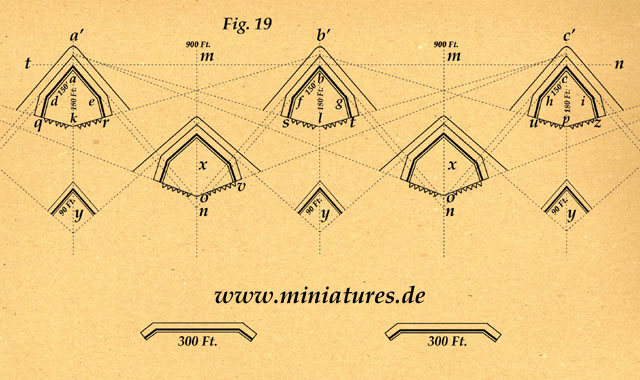Lunette

A lunette is a small bastion, detached and isolated, whose faces are from 120 to 150 feet, and the flanks 36 to 50 feet, which is employed in systems in the same manner as the arrow, to fulfil certain particular conditions. See b (fig. 17).
Of the Front covered by Lunettes
To fortify the front of a position by means of detached lunettes, the front t n (fig. 19) must be divided into equal parts a b, b c etc. of 250 to 320 yards in length,* and the intervals bisected; draw the perpendiculars m n, m n through the points of division upon t n; make m n, m n, greater than a m, m b, or a little more than half the front, and join the points, a, n, b, [n], c, by the lines a n, n b, b n, n c, these straight lines are the directions of the magistral. The flanked angles d a e, f b g, h c i, are greater than right angles. In order to obtain the faces of the lunettes, take a d, a c, b f, etc. each equal to from 40 to 50 yards. Before drawing the gorges and the flanks, a’ o, o b’, etc. must be drawn parallel to the magistral lines, and at such a distance as to represent the outer slope or foot of the counterscarp, and having made a k, b l, c p, etc. 60 yards in length, the straight lines k b’, a’ l, l c’, will be the directions of the demi gorges, to which the perpendiculars d q, e r, f s, etc. must be drawn which will be the flanks.

The defence may consist in these first lunettes alone, but in order that the salients may be more difficult of access, a second line x, x, is established, whose pieces should flank those in the first line. The faces of these second lunettes are also about 40 yards in length, and perpendicular to the first.
A third line of redans, y, y, y, is sometimes established, whose faces are made at least 30 yards in length.
In order that the ditches of advanced works may be defended by the fire of those in the rear, they must be prolonged in a straight line opposite the flank, and conducted in a slope beyond the line of the gorge, instead of making them follow the magistral of the flank. To prevent the enemy from entering these lunettes at the gorge, it must be closed by a row of palisades. Toward the middle of the gorge a passage is left which is defended by abatis or other obstacles. If the gorge were defended by a parapet, the enemy would be covered by it when he had penetrated into the work, instead of which palisades can be destroyed by the fire of cannon, and then the enemy is without shelter.
When it is wished to cover more ground with the entrenchment, it may be composed of a central redan, and two branches in the form of crémaillères.
To fortify the front of a position in this manner, square redoubts are sometimes made, and in order that they may flank each other, one of the diagonals is placed upon the capital.
When cavalry is to be placed in a defensive attitude, épaulements r should be erected 9 feet in height, behind which it is sheltered until it can enter into action, instead of being uselessly exposed to the effects of artillery.
* If it is not wished to make use of the crossfire of musketry, but of cannon only, the salients may be at the distance of 700 yards, which is the range of grape shot, or of 1400 to 1600 yards, so that the fire of grape will meet midway.
Source: Lallemand, Henri Dominique: A Treatise on Artillery (New York 1820)